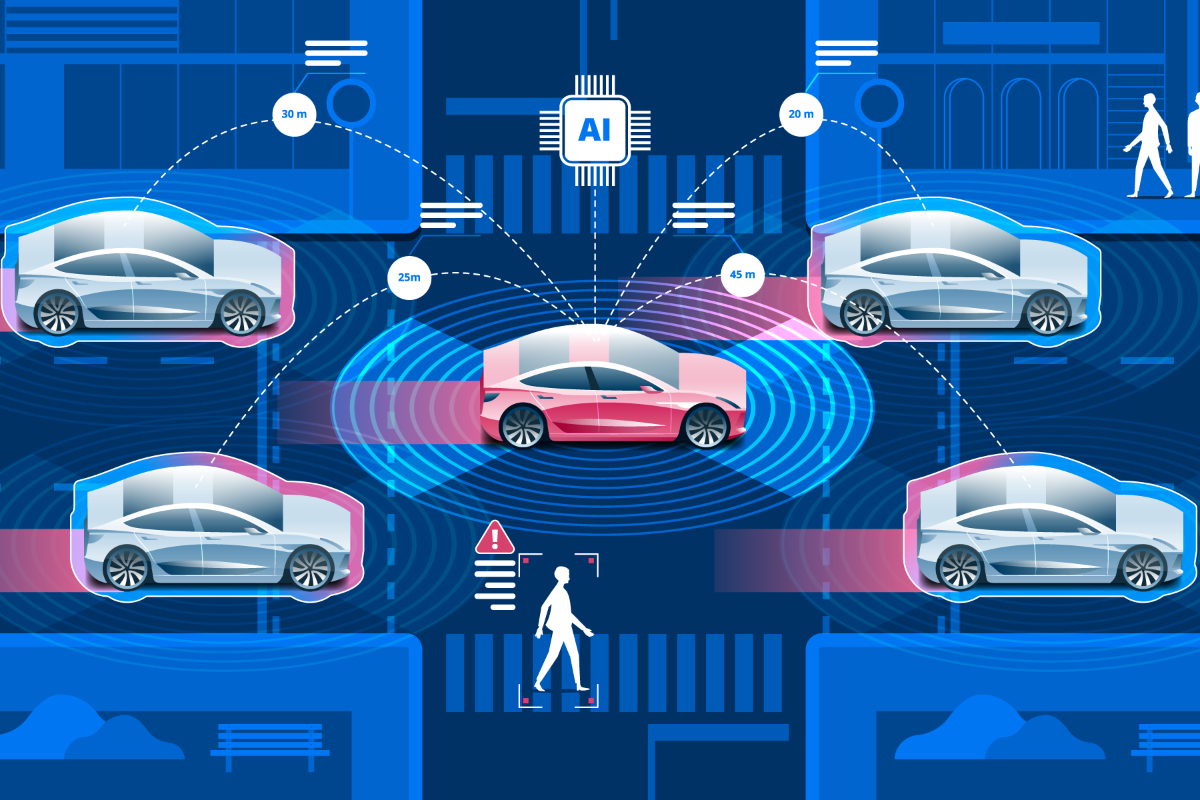The automotive industry is experiencing a revolutionary transformation, and at the heart of this evolution lies the autonomous vehicles market. Autonomous vehicles (AVs), also known as self-driving cars, are no longer confined to the pages of science fiction. They are real, operational, and slowly becoming an integral part of modern mobility ecosystems.
From advanced driver-assistance systems (ADAS) to fully autonomous level 5 vehicles, the autonomous vehicles market is redefining how people commute, how goods are transported, and how transportation infrastructure will be developed in the coming decades. In this blog, we’ll examine the current landscape of the autonomous vehicles market, technological developments, leading players, challenges, and the road ahead.

Understanding Autonomous Vehicles
Autonomous vehicles are equipped with technology that enables them to navigate and operate without human intervention. These systems rely on a combination of hardware and software, including sensors, cameras, LiDAR, radar, GPS, and AI-based control systems. AVs are categorized based on SAE (Society of Automotive Engineers) levels, ranging from Level 0 (no automation) to Level 5 (full automation under all conditions).
Currently, most commercially available vehicles are operating at Level 2 or Level 3 autonomy, with major players testing prototypes at Levels 4 and 5.
Current Market Overview
The autonomous vehicles market is expanding rapidly, driven by breakthroughs in artificial intelligence, machine learning, edge computing, and sensor technologies. As of 2025, the market is valued in the tens of billions and is expected to witness exponential growth over the next decade.
This growth is supported by increasing investments from tech giants, traditional automakers, and venture capital firms. Pilot programs and partnerships between private and public sectors are also being launched globally, especially in regions with strong infrastructure and policy frameworks.
Key Drivers of Market Growth
1. Advancements in AI and Sensor Technologies
High-resolution sensors, real-time data processing, and deep learning algorithms are enabling AVs to better understand and react to complex driving environments.
2. Increased Demand for Safer Transportation
Human error is the leading cause of road accidents globally. AVs have the potential to significantly reduce collisions and improve overall traffic safety.
3. Urbanization and Smart Cities Initiatives
The push for smart city solutions includes integrating autonomous vehicles into public transport systems, logistics, and urban planning, enabling more efficient mobility.
4. Rising Investments and Collaborations
Major investments from companies like Tesla, Waymo (Alphabet), Apple, Nvidia, and traditional automakers like Ford, GM, and Toyota are accelerating development cycles.
5. Environmental and Regulatory Pressures
As governments promote low-emission and electric vehicles, AVs—many of which are designed as electric—align with environmental goals and policy incentives.
Applications of Autonomous Vehicles
-
Passenger Vehicles: Ride-hailing services, personal transport, and shared mobility platforms.
-
Commercial Fleets: Delivery trucks, long-haul freight transport, and logistics optimization.
-
Public Transportation: Autonomous buses and shuttle services in cities.
-
Military and Defense: Unmanned ground vehicles for logistics and surveillance.
-
Agriculture and Mining: Use of autonomous tractors and transport vehicles in controlled environments.
Regional Insights
-
North America: Leads in innovation, infrastructure, and pilot deployments, especially in the U.S.
-
Europe: Focuses on regulation and safety, with Germany and the UK as key players.
-
Asia-Pacific: China, Japan, and South Korea are heavily investing in AV R&D and deployment.
-
Middle East & Africa: Emerging interest, with smart city projects like NEOM in Saudi Arabia.
-
Latin America: Slower adoption but increasing trials and government support in urban centers.
Challenges to Overcome
While the autonomous vehicles market is promising, several challenges must be addressed before mass adoption becomes a reality:
-
Regulatory Hurdles: Uniform policies and legal frameworks are lacking across countries.
-
Ethical Dilemmas: Questions surrounding decision-making in accidents remain complex.
-
Public Trust: Many consumers still have concerns about safety and reliability.
-
High Development Costs: Building and testing autonomous vehicles require massive investments.
-
Cybersecurity: AVs are susceptible to hacking and need robust security measures.
These challenges also bring the topic of data protection to the forefront. With AVs collecting vast amounts of real-time user and traffic data, cybersecurity concerns are rising, drawing attention to industries like the cyber insurance market for managing associated risks.
The Road Ahead: What the Future Holds
The future of the autonomous vehicles market is closely tied to the evolution of complementary technologies and regulatory readiness. Some notable trends to watch include:
-
Integration with Electric Vehicles (EVs)
AVs and EVs are a natural fit. Expect more autonomous electric cars as sustainability becomes a key selling point. -
Fleet-as-a-Service (FaaS)
Mobility as a service (MaaS) models will increasingly incorporate autonomous vehicles, especially in urban centers. -
Enhanced Connectivity with 5G
The low latency and high bandwidth of 5G will improve vehicle-to-everything (V2X) communication, essential for AV performance. -
Increased Adoption in Logistics
From last-mile deliveries to autonomous freight corridors, logistics will be a major benefactor of AV technology. -
Policy and Standardization
The development of global safety standards and certifications for autonomous vehicles will be crucial for broader acceptance.
Conclusion
The autonomous vehicles market represents a seismic shift in the global transportation landscape. While the path to full autonomy is complex and filled with technical, ethical, and regulatory obstacles, the momentum is undeniable. As technology evolves and infrastructure adapts, AVs are set to redefine mobility, safety, and convenience for future generations.
With continued collaboration among technology developers, policymakers, and transportation providers, the dream of widespread autonomous mobility is inching closer to reality.
Related Trending Reports| Gaming Accessories Market |
| Fire Protection System Market |
| Sports Technology Market |
| Smart Building Market |
| Smart TV Market |